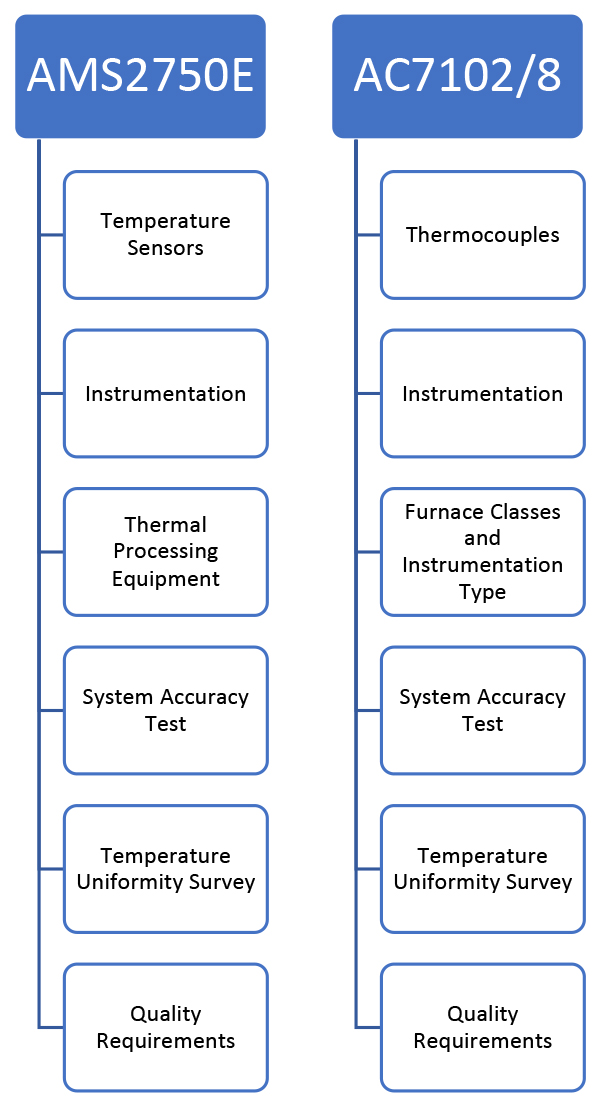When I consult, I will periodically perform a gap analysis on a supplier’s heat-treat process to either obtain Nadcap approval or as a check-and-balance to maintain and/or improve their process. While performing this task, I examine the supplier’s procedures and work instructions in detail to ensure all required items are contained within the documents. Over the years, I’ve been able to notice those procedures that flow in a logical, easy-to-understand format and those that have been pieced together whenever a supplier inserts new statements due to findings or a major specification revision. The latter creates a document that does not flow in a matter conducive to comprehension for the staff who must follow the instructions.
When documenting the necessary instructions to ensure product and/or process conformance, the aggregation of the specification must be well understood.
In this article, we will explore the aggregation of AMS2750E and Nadcap requirements regarding pyrometry.
Understanding AMS2750E & Nadcap Requirements
I’ve written several articles regarding the technical requirements of AMS2750E; documenting how a supplier conforms to those requirements is just as important. As I’ve stated before, AMS2750E is written in a manner that a novice or someone new to pyrometry may have a difficult time comprehending the statements within the specification. Understanding the statements within AMS2750E takes training in both the technical terms used as well as the actual testing itself. Having a good understanding of different types of furnaces is also imperative in ensuring the correct requirements are being applied to your operations. Once these items have been accomplished, your understanding of AMS2750E will be at a level where you may feel comfortable drafting a pyrometry procedure that will, hopefully, reflect conformance to the aspects of AMS2750E and Nadcap that apply to your operations.
 The Layout
The Layout
When writing a procedure, it’s important to visualize the content and its flow from the perspective of the readers. With regard to pyrometry, following the flow of AMS2750E will be helpful to the reader as this will help when a comparison is made between the specification and the procedure. An example of this method can be seen when examining Nadcap’s Pyrometry checklist AC7102/8 against AMS2750E. As you can see in the example, the two documents progress in parallel with regard to topic.
This is not to say that AMS2750E and Nadcap’s AC7102/8 are identical in their layout and flow (including topic titles), but they are close enough in the major categories to ensure readers of both can make quick comparisons.
Single Point of Reference
Over the years, I’ve performed many gap-analyses and internal audits for suppliers looking to obtain or improve (merit process) their Nadcap accreditation. While performing these tasks, I often see suppliers who have separate work instructions/procedures for each category. For example, they may have a single document intended to account for sensor (thermocouple) requirements and the same scenario for both system accuracy testing and temperature uniformity surveys. This would mean that, if a requirement for an SAT sensor changes, this particular supplier may need to modify two procedures to account for the changes; the sensor procedure as well as the system accuracy testing procedure. This scenario increases the opportunity for error when modifications must be made.
With this in mind, it may be more logical to place all pyrometry requirements within a single work instruction/procedure to ensure that, when a requirement changes, it can be accounted for in all of the pyrometry requirements that the change may affect, rather than have separate documents for each AMS2750E topic.
Content Applicability
When writing a procedure to account for AMS2750E, it should not be a copy of AMS2750E. In other words, if a specific topic within AMS2750E does not apply to your operations, you may be better served to omit the topic altogether. As an example, if your heat-treat operation consists of vacuum furnace brazing only, and each furnace is a Type B instrumentation type, it wouldn’t be logical to include Types A, C, or D within your procedure. With this example in mind, it would also be logical to omit retort furnace requirements since this example includes none. On the face of it, this may seem to be common sense, but in practice, I see this scenario from time to time. This type of practice may have several repercussions: 1) an auditor who is knowledgeable may see this as a lack of training, and 2) that the supplier did not take the time to write the procedure as it applies to their operation. This may, in turn, push the auditor to examine items more closely as errors will be more likely to exist within not just documentation, but the processing of parts within the equipment.
Summary
There are many different suppliers who must conform to AMS2750E Nadcap, all of whom have an infinite combination of processes, materials, furnaces, and prime requirements. Therefore, attempting to use a cookie-cutter procedure template to merely fill in would be detrimental to the core purpose of a procedure/work instruction. It would be beneficial to include applicable requirements within a single procedure which accounts for all requirements which flow in the same manner as AMS2750E.
I will be presenting this topic at the Furnaces North America Show 2018.






























